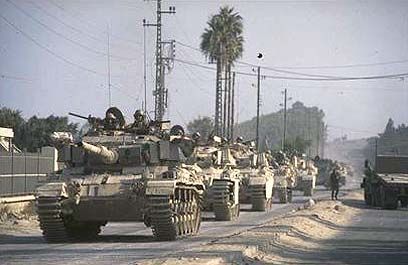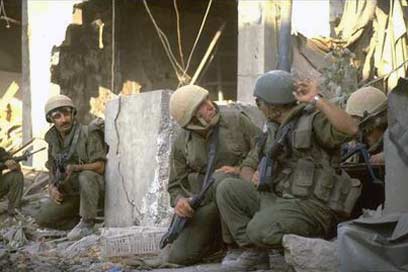
The Lebanon War
A limited operation in South Lebanon that escalated into an 18-year military involvement
But even with the IDF controlling several outposts within the buffer zone itself, the PLO managed to slip back into the region and other areas (southeast Lebanon and the slopes of Mt Hermon, where the SLA was not present), quickly regaining its power.
The buffer zone was expanded and relabeled the “security zone.” However it was colloquially knows as “Fatahland” and the armed Palestinian groups launched numerous attacks from the region.
Meanwhile as Israel clashed with the Palestinians in southern Lebanon and tried to strengthen the SLA, it also held covert talks with Christian leaders in Lebanon who feared an independent Palestinian presence in their country. The Christian leaders were also alarmed about the deterioration in their standing within national politics. The agreements made during these talks were not made public but they would serve a crucial role in the events to come.
In July 1981 the US negotiated a ceasefire between Israel and the PLO. However the ceasefire was violated and on June 3, 1982, Israel’s ambassador to London, Shlomo Argov, was shot and critically wounded by a gunman belonging to Ahmed Jibril’s movement. Then-Prime Minister Menachem Begin convened the government for a special session and a majority cabinet vote authorized attacks against targets in Beirut and southern Lebanon. The PLO responded harshly, shelling Israel’s northern towns and particularly Kiryat Shmona.
On June 6, the IDF entered Lebanon. The government announced that Israel’s objective was to force the armed groups northward, removing northern Israel from their range. The operation was meant to last only 48 hours, during which the army would only reach some 40 km into Lebanese territory. But the army hurdled ahead and ended up reaching the city of Beirut. Some cabinet ministers later accused then-Defense Minister Ariel Sharon of hiding the army's real plans from them.
As Israeli forces pressed northward, another front developed as Syrian forces launched an offensive in eastern Lebanon. Israel had said publicly that it had no desire to engage Syria but the clash proved unavoidable.
Syria sent reinforcements to the Bekaa Valley and launched an attack against IDF troops. In response, the Israel Air Force (IAF) destroyed most of Syria’s missiles situated on Lebanese territory. During the subsequent air battles, 27 Syrian planes were shot down. In total, the Syrians lost approximately 100 aircraft in the war.

IDF forces in Tyre (Photo: AP)
On the western front the IDF had completed its encirclement of Beirut by June 14. Joined by Christian Phalangists in the eastern sector of the city, the plan was to impose a “new order” in Lebanon.
The plan was Sharon's brainchild and its stated objective was to help transform Lebanon into an independent country, free of armed Palestinian groups and ruled by the country’s Christian leaders.
Israeli troops would cut off the Beirut-Damascus route; reach eastern Beirut and station forces in eastern Lebanon should Syria attempt to intervene. The IDF would then join with the Lebanese Christian forces; the latter would have meanwhile launched an operation against the Palestinians in the north. According to the plan, Lebanon would come under Christian control and a government led by Bashir Gemayel would sign a peace treaty with Israel.
From July to mid-August the IDF laid siege to Beirut in an attempt to force the PLO and Syrian troops from the city’s western sector. The encirclement was gradually tightened as the IDF gained control of more neighborhoods and after intense fighting and a heavy bombardment of Beirut on August 11-12, the PLO agreed to withdraw.
The PLO’s retreat began August 25 under the control of multinational force led by several US Marine units. Yasser Arafat was one of the last to leave the city.
During those days Christian forces leader Bashir Gemayel was elected president of Lebanon and the “big plan” seemed to be on its way. But on September 14 Gemayel was assassinated in a massive explosion on the roof of the Christian Phalange building in Beirut.
In the aftermath the IDF entered western Beirut. Israeli government members heard the news of the Israeli incursion on the radio and no one could say how the decision had been made.
Sabra and Shatila
The IDF and the Christian Phalangists had resolved that the latter would deal with any remaining terrorists in the western sector of Beirut. It was also decided that the Phalangists or the SLA would comb through the refugee camps in search of remaining terrorists and hand them over to the IDF.
However the Phalangists who entered the Sabra and Shatila refugee camps in September 1982 chose to exact revenge after the murder of their leader and massacred some 800 Palestinian civilians.

IDF force on the lookout
Despite previous IDF intelligence assessments which warned of a potential massacre and despite the unambiguous reports which reached Sharon and Chief of Staff Rafael Eitan, the IDF did nothing to prevent the massacre.
The massacre resulted in a local and international onslaught. In Israel the Peace Now movement organized a massive rally in Tel Aviv as Prime Minister Begin came under intense pressure to establish a committee of inquiry.
Begin initially preferred a less formal investigation but was ultimately forced to comply with public opinion and in late September he appointed then-High Court of Justice President Yitzhak Kahan to head a committee of inquiry.
The committee’s findings declared Sharon unfit to hold the post of defense minister and he was indeed dismissed.
The 18-year withdrawal
In the aftermath of the massacre, the IDF left western Beirut and the multinational force reentered the area. The US began brokering talks to facilitate the withdrawal of all foreign armed forces from Lebanon – Syria, the PLO and Israel. In talks between Israel and the new Lebanese government, headed by Bashir’s brother Amin Gemayel, a peace agreement was agreed upon. But Lebanon backed out of the agreement due to intense Syrian pressure and internal opposition.
The IDF gradually retreated southward, suffering heavy losses on the way as many of the sectarian militias in the country had allied themselves with Hizbullah in order to force the IDF out of Lebanon.
Major attacks during this time include the bombing of an IDF headquarters in Sidon (36 Israelis were killed) and two separate attacks on October 23, 1983, in which 241 American citizens and 58 Frenchmen were killed. The multinational force was subsequently disbanded.
In the Chouf Mountains, which Israel had come to control in June 1982, the IDF was forced to deal with continuous clashes between Christian and Druze Lebanese, the latter led by Walid Jumblatt. Israel’s entanglement in Lebanon became known as “the Lebanese mud” as IDF losses piled up and the fighting dragged on. The Lebanese government found itself unable to rein in the opposing forces and the region descended into anarchy.
The war was seen in Israel as a “war of choice,” meaning Israel was trying to achieve political goals through military action, as opposed to Israel’s previous wars in which the country was struggling for its existence against external threats. With no apparent end to the fighting in sight and growing internal opposition, the war was one of the reasons which prompted Prime Minister Begin’s resignation on August 23, 1983.
In January 1985 the Israeli government voted to gradually withdraw from Lebanon in stages and by the end of that year most Israeli troops had retreated to the international border. A limited number of soldiers remained behind however as part of the IDF’s cooperation with the SLA to try and maintain the buffer zone.
Over the course of the next 15 years the IDF would launch two large-scale operations in Lebanese territory (Operation Accountability and Operation Grapes of Wrath) in an attempt to prevent Hizbullah’s continuing artillery attacks against northern Israel.
Ehud Barak, who was elected prime minister in 1999, led his government to vote for a complete withdrawal from Lebanon and the last Israeli soldiers left Lebanon on May 24 2000.










